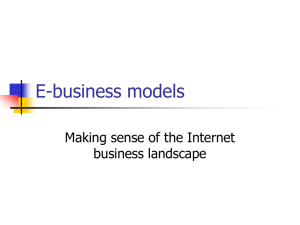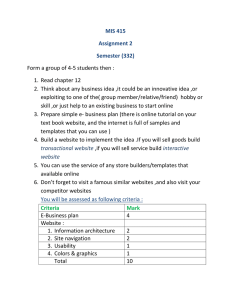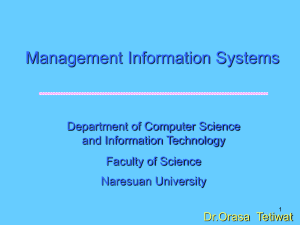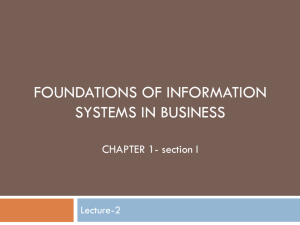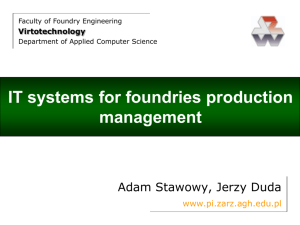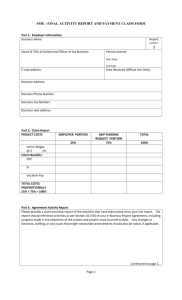THE STRATEGIC USE OF IT
advertisement
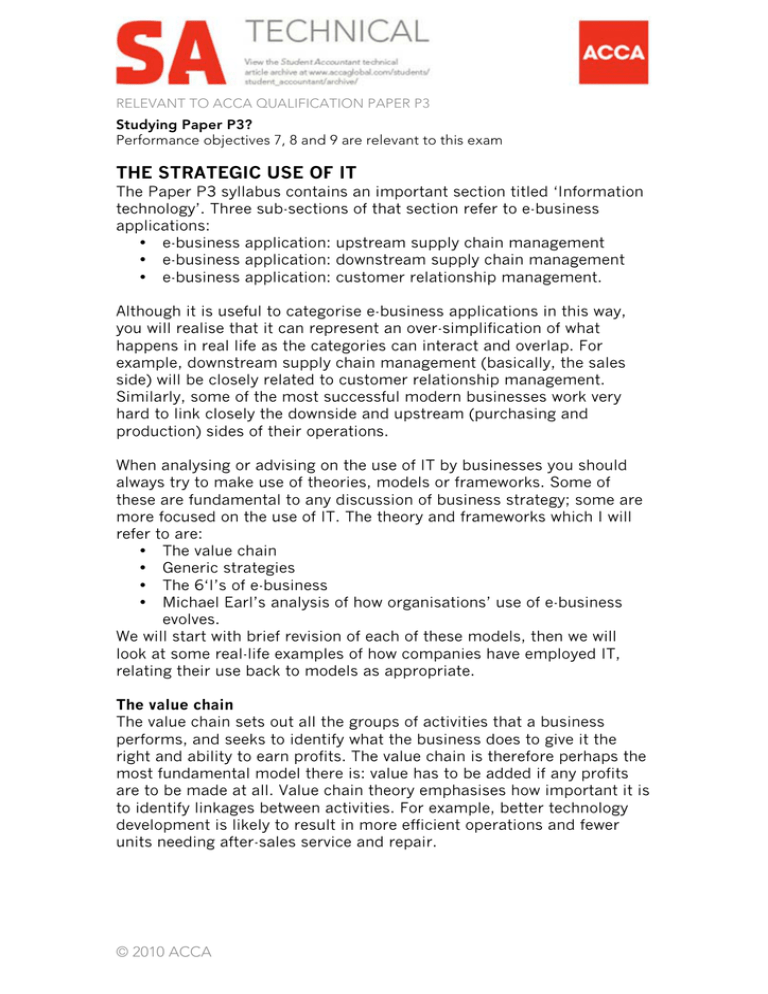
RELEVANT TO ACCA QUALIFICATION PAPER P3 Studying Paper P3? Performance objectives 7, 8 and 9 are relevant to this exam THE STRATEGIC USE OF IT The Paper P3 syllabus contains an important section titled ‘Information technology’. Three sub-sections of that section refer to e-business applications: • e-business application: upstream supply chain management • e-business application: downstream supply chain management • e-business application: customer relationship management. Although it is useful to categorise e-business applications in this way, you will realise that it can represent an over-simplification of what happens in real life as the categories can interact and overlap. For example, downstream supply chain management (basically, the sales side) will be closely related to customer relationship management. Similarly, some of the most successful modern businesses work very hard to link closely the downside and upstream (purchasing and production) sides of their operations. When analysing or advising on the use of IT by businesses you should always try to make use of theories, models or frameworks. Some of these are fundamental to any discussion of business strategy; some are more focused on the use of IT. The theory and frameworks which I will refer to are: • The value chain • Generic strategies • The 6‘I’s of e-business • Michael Earl’s analysis of how organisations’ use of e-business evolves. We will start with brief revision of each of these models, then we will look at some real-life examples of how companies have employed IT, relating their use back to models as appropriate. The value chain The value chain sets out all the groups of activities that a business performs, and seeks to identify what the business does to give it the right and ability to earn profits. The value chain is therefore perhaps the most fundamental model there is: value has to be added if any profits are to be made at all. Value chain theory emphasises how important it is to identify linkages between activities. For example, better technology development is likely to result in more efficient operations and fewer units needing after-sales service and repair. © 2010 ACCA 2 THE STRATEGIC USE OF IT OCTOBER 2010 There is no problem at all seeing how information technology could be used in each activity: Value chain component Firm infrastructure Technology development Human resource management Procurement Inbound logistics Operations Marketing and sales Service Examples of the use of IT Accounting system, corporate intranet, email Computer aided design, automated software testing, internet searches for new discoveries and processes Skills databases, manpower scheduling, computer based training, performance monitoring Ordering process, supplier databases Material resource planning (MRPI), manufacturing resource planning (MRPII), just-in-time inventory management Computer aided design, computer aided manufacturing, automated production lines, robotics E-commerce, internet advertising, customer relationship management Fault monitoring, quality control systems, computer aided design. However, just because IT can be used does not mean that value will be added, and if value is not added profits cannot be improved. Inappropriate use of IT could harm a company’s prospects. For example, there is little point in automating production if what your customers cherish are hand-made, individualised products. © 2010 ACCA 3 THE STRATEGIC USE OF IT OCTOBER 2010 Generic strategies The value chain explains why profits are earned, but all businesses seek competitive advantage, that is, the ability to make above average profits in the long-run. Michael Porter suggests that competitive advantage can be obtained in two main ways: • cost leadership • differentiation. Additionally, each of these generic strategies might or might not make use of a focus strategy. However, the use of IT will not necessarily generate competitive advantage. For example, if the IT being used is package software, almost by definition this will mean that many competitors are likely to be using the same package. It is difficult to see how a package will of itself give a particular company any advantage over its rivals and such IT is likely to be the starting point (threshold capability) rather than a provider of strategic capability. ‘Ordinary IT’ is likely to be everyone’s starting point and the successful company needs to do more – either by using non-standard IT (a unique resource) or by using their IT in a better way (a core competence). In addition to the generic strategies set out above, IT developments can also offer the possibility of an organisation discovering and setting up an entirely new business opportunity. For example, the internet enabled Apple to ‘invent’ iTunes, and now legitimate mp3 downloads have overtaken high street CD sales. Similarly, Skype allows very cheap phone calls to be made over the internet and this is a major challenge to traditional telecommunication companies. The 6‘I’s of e-business This model is particularly useful when analysing the downstream side of businesses (the marketing, distribution and sales functions) but can also be relevant elsewhere. The 6‘I’s are: Intelligence Every click a website visitor makes can be recorded and analysed. If the website asks users to log-in, then a user history can be created Individualisation Previous purchases and areas of interest can be recorded and used to give value to the user. For example, travel sites allow users to look up the trips they have booked. Each user gets a tailored service. Interactivity For example, website users can browse different products and adjust their purchases (shopping cart) until they are happy. Integration Once ordered, the purchases, production and dispatch systems can be triggered automatically. © 2010 ACCA 4 THE STRATEGIC USE OF IT OCTOBER 2010 Independence Industry It does not matter where the website is physically located. Businesses have become independent of location. Industry structures can be changed. Look at how the music business is still trying to come to terms with mp3 technology Michael Earl’s analysis of how organisations’ use of e-business evolves. Earl suggested that business use of e-business technology progresses through the following stages: External communication Internal communication E-commerce E-business E-enterprise Transformation A web presence An intranet Buying and selling Buying and selling, plus the capabilities to match Management processes and business processes are redesigned. Transactions can be monitored and analysed real-time. New business and management models required for the new economy are embedded. As is said by Earl: ‘The six stages are ‘ideal types’, stylistic phrases which capture – even caricature – the experiential learning of these companies; thus they are not necessarily definitive periods of evolution from old economy to new economy corporations. However we do find most companies identify with the model.’ The particularly interesting elements of these steps are: • E-commerce/e-business. It is recognised that companies often try to run before they can walk. Their website promises efficient transactions but their systems simply cannot deliver so that the dispatch of goods is unreliable and errors are made. All this manages to do is advertise the firm’s incompetence to an international clientele. • E-enterprise. Management processes and business processes are redesigned. Transactions can be monitored and analysed realtime. It’s the ‘real-time’ element that’s important here. For example, analysing sales as they happen and adjusting purchasing and production in response. • Transformation. New business and management models required for the new economy are embedded. For example, iTunes as mentioned above. © 2010 ACCA 5 THE STRATEGIC USE OF IT OCTOBER 2010 Examples of the strategic use of IT There now follows a number of examples of how businesses have harnessed IT and e-business to create competitive advantage. Tesco Tesco plc is the leading supermarket chain in the UK. In the early 1990s all supermarkets developed the idea of linking to their suppliers so that orders could be sent electronically when inventories reached their reorder levels (EDI, or electronic data interchange). However, although this gave great cost efficiencies, it did mean that suppliers could still be taken off-guard when orders were received. At the end of the 1990s Tesco developed the Tesco Information Exchange system (TIE), which enables Tesco’s suppliers to monitor sales and stock levels of their products at Tesco branches. Therefore, suppliers are more aware of when deliveries are needed as they can perform their own specialist forecasts of demand and more closely integrate their production of goods, dispatch and delivery to supermarkets. This process can be extended so that instead of a supermarket placing an order, suppliers know when they need to deliver to supermarkets. Suppliers monitor their own stocks at the supermarket branches and this enables even closer integration with their customers. Through technological development Tesco has greatly improved its procurement, inbound logistics and supply chain management. For example, if a product promotion is being run by Tesco, suppliers can watch closely the effect of the promotion on demand and react accordingly. This is an example of management processes and business processes being redesigned so that transactions can be monitored and analysed real-time. Costs are reduced and customer service is also improved, which gives the company competitive advantage. Zara Zara is the leading brand of the Spanish retail group Inditex SA. It is based in A Coruña, North West Spain. It sells clothing through its international chain of shops. Traditional large clothing retailers had very long design, manufacturing and distribution times. Typically design of new fashions would start 12 months in advance of a season. Very large quantities of garments would then be ordered – enough to last the whole season. Large volume production and relatively stable inventory lines allowed these companies to keep their costs down. However, you will understand that if planning starts a year in advance, the clothes that result might not represent the © 2010 ACCA 6 THE STRATEGIC USE OF IT OCTOBER 2010 latest fashions and the large orders meant that expensive mistakes could be made. Zara takes a very different approach. Its development time of a new article of clothing is typically 4–6 weeks, and that covers design, manufacturing and distribution. Its clothes, therefore, have an excellent chance of looking up to date; around 12,000 –15,000 different styles are produced each year. Furthermore, the company deliberately under-produces so that maximum demand is often not met. This means that there is relatively little chance of having to mark down excess, unsold clothing. Low volumes also mean that when an item is sold out it will usually not reappear in a store, so customers know that they have to buy now as that might be their only chance. Frequent inventory changes repeatedly draw customers back to the stores to see what new lines might be in. Fairly obviously, many designs, produced in relatively small quantities could have an adverse cost effect compared to traditional large scale mass. Therefore, the company makes extensive use of IT to allow its clothes to be quickly designed, made and sold at competitive prices. Computer aided design, computer aided manufacture, and efficient distribution methods are all vital in allowing the company simultaneously to be cost effective and to differentiate. The company has redesigned its management and business processes to give customers added value through the production of very up-to-date and frequently revised clothing lines. It should also be mentioned that because Zara adopts a very rapid inventory production and replenishment system (not just-in-time, but moving in that direction), it is essential that the company and its producers work closely together. Not only do their information flows have to be well-coordinated, but they often have to be physically close as well so that raw material can be delivered and the manufactured goods checked and distributed efficiently. A much higher proportion of Zara’s suppliers are located close to the company’s head office than is found in most other clothing retailers who tend to manufacture most of their goods in lower-cost production areas in Asia. Dell Dell is a maker of desktop and laptop computers. It is famed for its justin-time inventory management system. Visitors to the Dell website (www.dell.com) are given a choice of several levels of machine, such as home, home-office and small business. Having chosen a base model, customers can then adjust those basic models by, for example, opting for larger hard discs, lower specification operating systems, different © 2010 ACCA 7 THE STRATEGIC USE OF IT OCTOBER 2010 screen sizes and so on. Typically about 20 customisation choices are provided. The recalculated price is shown and the buyer can make further amendments as required. When the ‘Buy’ option is chosen and payment taken, production of the machine begins. Every half hour, Dell consolidates all its online and telephone orders and produces parts lists and manufacturing schedules (manufacturing resource planning, MRPII). The specifications of the parts required are transmitted to suppliers who have to deliver within the hour. Obviously, to meet this time limit manufacturers have to be located close to Dell or have their own warehousing facilities on Dell’s site. The parts are taken directly from delivery trucks onto the production line and production commences. There is effectively no raw material stock, and inventory consists only of the small amount of work-in-progress and the completed units being tested and delivered. The whole purpose of the system is to reduce inventory, and to provide flexible and fast responses to customer requirements. The company has integrated its downstream and upstream supply chains very closely and manages to combine very low cost production with differentiation through customisation. It is certainly at the e-enterprise stage of IT use. Amazon Amazon began life as an online book seller, but now its products extend to a very wide range of consumer goods. The selling price of the goods is usually lower than can be matched by high street stores as the business model does not depend on retail premises and rents; the operation has achieved geographical independence. The company excels at customer relationship management and relationship marketing. Relationship marketing seeks to attract, maintain and enhance customer relationships by focusing on the whole satisfaction experienced by the customer when dealing with the firm. The company provides an excellent example of e-business and all of the 6Is. To buy from Amazon, you need to open a user account and this enables the company to begin forming its relationship with you. If you express interest in a product the following typically happens: • You are told the other customers who ordered that product frequently also ordered certain other products (perhaps of similar type or subject matter). • You can read other customers’ reviews of the product. • You can sample snatches of CDs. • Very full technical specifications are provided. © 2010 ACCA 8 THE STRATEGIC USE OF IT OCTOBER 2010 You can easily locate other products by the same author, artist or manufacturer. • You can see if the item is in stock and how long you might have to wait for it. Once the product is ordered: • You are given an estimated delivery date. • You will be given a choice of delivery methods, times and costs. • You are sent an email confirming the purchase details. • You are informed when the item has been dispatched. • Often you can trace the progress of the item through the shipping system. • If there’s a problem you will be informed. After delivery: • You can submit a review of the item. • You will be alerted (if you want to be) of other items that might be of interest (for example new books or CDs by the same writer or performer). • Amazon has added value by holding an immense range of inventory, providing customer convenience, charging very competitive prices, looking after its customers very well indeed so that customer loyalty is created. Rolls Royce aero engines This company provides an illustration of the strategic use of IT which goes beyond the usual examples of inventory control and website design. Although there are relatively few firms in the aero engine market, it is very competitive environment. Rolls Royce (RR) competes not just by making the initial sale, but by selling lifetime care of the engine. The initial sale is relatively low cost, and profit is earned over the life of the contract. What the company has developed is a system called Engine Condition Monitoring (ECM) in which the airlines have effectively turned over engineering and engine maintenance to RR. The company has added value to what it’s offering and built close relationships with its customers through advanced use of IT, which is used to reduce maintenance costs and service disruption. ECM is additional to the normal safety systems and inspections managed by the airlines. Engines are fitted with about 25 sensors which continually monitor conditions and transmit the data back to RR in Derby, UK. There, sophisticated IT methods (including artificial intelligence techniques) are used to analyse the data and identify significant events. These can © 2010 ACCA 9 THE STRATEGIC USE OF IT OCTOBER 2010 then be notified to RR engineering staff and to the airline so that preventative checks and maintenance can be carried out. IT has been used to add value by giving customers much better service, reliability, safety and lower costs. The company has achieved great success through a transformation of the way aero engines are sold and maintained. Ken Garrett is a freelance author and lecturer © 2010 ACCA
